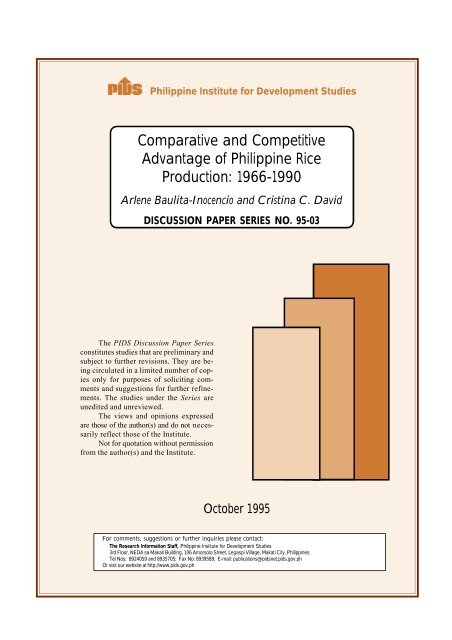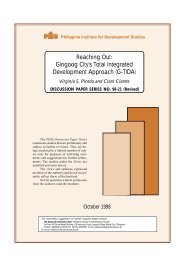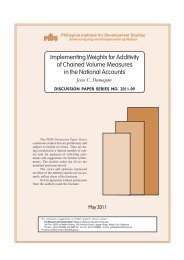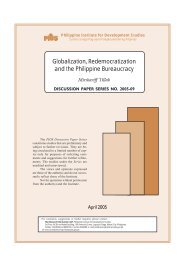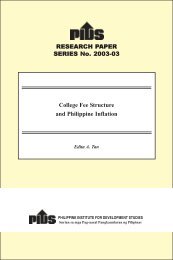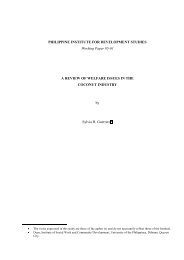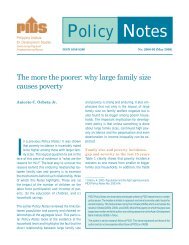Comparative and Competitive Advantage of Philippine Rice ...
Comparative and Competitive Advantage of Philippine Rice ...
Comparative and Competitive Advantage of Philippine Rice ...
Create successful ePaper yourself
Turn your PDF publications into a flip-book with our unique Google optimized e-Paper software.
prior to I965 to 3.6% in the 1965-1980 period.Unfortunately, that strong growt!l performance was not sustained in the 1980's; growthrate o_fproduction declined to 2.0% due both to a slowdown ill the growth rate in yields <strong>and</strong> avirtual halt in the expanston ot crop area plantea to rice. As a result, the country resumedimporting rice by 1982 <strong>and</strong> has done so in 5 out <strong>of</strong> I0 years since then.Evidently, the gainsin comparative advantage in rice production in the 1970's (Unnevehr 1986) have been dissipatedby the 1980's as population growth surpassed growth in production.Clmuges in tile degree <strong>of</strong> comparative advantage may be accotmtcd fur by It-endsiu thesocial opportunity cost <strong>of</strong> l<strong>and</strong>, labor, <strong>and</strong> foreign exchange, world price <strong>of</strong> rice <strong>and</strong> tr:ldabl¢inputs, <strong>and</strong> the growth in productivity due to technological change. The changing trade balance,however,may also reflect changes in government price intervention policies which by directlyor indirectly affecting the structure <strong>of</strong> farmers' incentives ,na3,cause changes in the country'scompetitive advantage in rice production.The first study to evaluate <strong>Philippine</strong> comparative advantage in rice by comparing thedomestic resource cost <strong>of</strong> rice production to the social opportunity cost (shadow) <strong>of</strong> exchangerate indeed showed that in 1974 the country had a comparative advantage in rice production(Herdt <strong>and</strong> Lacsina 1976).Unnevehr's (1986) historical analysis <strong>of</strong> comparative advantage inrice production from 1966 to i982 indicated that this was not initially the ease prior to the1960's before the widespread adoption <strong>of</strong> the modern rice technology. The country'scomparative advantage improved between 1966 to 1974 primarily due to the higher world price<strong>of</strong> rice <strong>and</strong> depreciation <strong>of</strong> the peso.It was not until after 1974 that the impact <strong>of</strong> technologicalchange in rice became the dominant factor accounting for the achievement <strong>of</strong> comparativeadvantage in rice production.There were already some indication <strong>of</strong> the erosion <strong>of</strong> tl_esegains
Methodology<strong>Comparative</strong> advantage in rice productionis evaluatedby a measure <strong>of</strong> social pr<strong>of</strong>itabilitycalculated as tile ratio <strong>of</strong> domestic resource cost (DRC) <strong>of</strong> foreign exchangeto the shadowexchange rate ($ER). The DRC is a measure <strong>of</strong> the value <strong>of</strong> domestic resources needed to earna unit <strong>of</strong> foreign exchange through exports or save a unit <strong>of</strong> foreign exchange through importsubstitution, reflecting the efficiency by which foreign exchange can be earned or saved bydomestic production <strong>of</strong> say, rice.It may be considered as its "own exchange rate" or the rateat which domestic resources priced at their social opportunity cost or shadow prices cntl I)c)converted i,ito foreign exchatlge via production <strong>and</strong> marketing<strong>of</strong> ricc. The SER, in turtb is theDRC <strong>of</strong> the marginal activity that would be chosen to balance the foreign exchange budget whenall DRCs <strong>of</strong> economic activities are ranked from lowest to highest. Thus, an activity with DRCthat is lower than the marginal one, or a resource cost ratio (DRClsFrOequal to less than unityreflects comparative advantage.And a decline in the resource cost ratio indicates an increasein comparative advantage.The DRC is calculated by the following formula:DRC1 - b bThe numerator denotes the cost <strong>of</strong> domestic non-tradea61efactors where the x_'sare quantitiesused per ton <strong>of</strong> rice produced <strong>and</strong> p("s tlleir shadow prices.These domestic factors arcprimarily l<strong>and</strong> <strong>and</strong> labor used directly <strong>and</strong> indirectly in the production <strong>and</strong> marketing <strong>of</strong> rice.In this study, the shadow wage is assumed to be equal to the market wage because the minimumwage law does not effectively influence the level <strong>of</strong> rural wages as employment isdominated by4
small-scale farming <strong>and</strong> informal non-farm work. Because <strong>of</strong> the l<strong>and</strong> reform law that prohibitsl<strong>and</strong> sales <strong>and</strong> share tenancy, we assume the cost <strong>of</strong> l<strong>and</strong> to be the residual after deducti,g thecost <strong>of</strong> aU other inputs from the value <strong>of</strong> output, where prices <strong>of</strong> all other inputs <strong>and</strong> ot,tput areirt terms <strong>of</strong> theix shadow prices.Where domestieaUyproduced inputs include some tradeableor foreign components, only the domestle components is included.In the denominator, the cost <strong>of</strong> tradeable or foreign sourced inputs is deducted from theborder price <strong>of</strong> rice estimated as the world price <strong>of</strong> 35% brokens rice (FOB Bangkok) adjustedby zuTo to account _or insurance <strong>and</strong> freight to the <strong>Philippine</strong> border. To remove the effect <strong>of</strong>world rice price instability, a five-year average <strong>of</strong> the world price is used. The cost <strong>of</strong> .tradeableinputs is calculated by multiplying their quantities, fl, with their respective border prices pi_'byusing conversion factors based on import duties, advance sales tax, knd price comparisons.Appendix Table 1 shows the allocation <strong>of</strong> inputs into tradeable <strong>and</strong> non-tradeable componemsincluding the share <strong>of</strong> cost accounted for by price <strong>and</strong> trade protection policies.Farmers allocate resources in response to market rather than to shadow prices.Thedegree by which domestic production <strong>of</strong> rice can compete in the world market, therefore,depends not only on the country's comparative advantage but on the impact <strong>of</strong> governmentpolicies on output <strong>and</strong> input prices, that is, the country's competitive advantage.Whereascomparative advantage is a measure <strong>of</strong> social pr<strong>of</strong>itabilit.y<strong>and</strong> uses shadow prices,including theSER, competitive advantage is a measure <strong>of</strong> private pr<strong>of</strong>itability <strong>and</strong> uses market prices tocompute for DRC <strong>and</strong> compares this with the <strong>of</strong>ficial exchange rate to compute for tl_eresourcecost ratio.Similarly, a value less than unity indicates advantage -- in this case, competitiveadvantage.5
Changes hi <strong>Rice</strong> FarmingCentral Luzon is the largest <strong>and</strong> the most progressive rice growing region in the country,a¢¢ount_g for about 25% <strong>of</strong> rice production <strong>and</strong> 20% <strong>of</strong> rice-crop-area. This region has themost favorable natural production environment for rice growing <strong>and</strong> has been the focus <strong>of</strong>government investments in irrigation, extension <strong>of</strong> modem rice technology, marketinfrastructure,<strong>and</strong> other agricultural support services. It is also the region with the mostsuccessful implementation <strong>of</strong> the L<strong>and</strong> Reform Law (Otsuka 1991). Although this region doesnot represent the marginal, nor the average rice production environment <strong>and</strong> technology,theIRRI Central Luzon farm survey provides an excellent basis for analyzing the changes in thetechnology, economic conditions, <strong>and</strong> institutional structure <strong>of</strong> rice production over the past 25years.Socio-eeonomic characteristicsTable 1 shows the changes in the socio-economie characteristics <strong>of</strong> the sample farms.Note that the number <strong>of</strong> farm samples varied through the years, with the decline attributable tothe retirement <strong>of</strong> some sample farms, refusal <strong>of</strong> others to be interviewed again, or their absenceduring the survey visits. These farmers were replaced, but it was not until 1979 that the samplewas significantly increased to maintain the representativeness <strong>of</strong> the sample llouseholds.Average farm size decreased over the whole period from more than 2 has to 1.8 has by1990. The increasing trend in the early period may be due in part to the changing <strong>of</strong> farmsamples. In the 1960's, the rice farmers were predominantly share-tenants, but because <strong>of</strong> l<strong>and</strong>reform, the structure <strong>of</strong> tenancy changed dramatically. The L<strong>and</strong> Reform Law <strong>of</strong> the early 1960swhich set the leasehold sharing to 75-25 in favor <strong>of</strong> the leaseholder led to the increase in the6
atio <strong>of</strong> leasehold farms from 13% to 35%. With theL<strong>and</strong> Reform Law <strong>of</strong> 1974 (PD 27) whichabolished share-tenancy, former share-tenants were converted into Icaseholdcrs or holders <strong>of</strong>Certificates <strong>of</strong> L<strong>and</strong> Transfer (CLT). By 1990, only a minor proportion<strong>of</strong> rice farmers remainedoas share-tenants by mutual choice.Two-thirds <strong>of</strong> the rice crop area was already irrigated by 1966. With the constrimtion inthe early 1970s <strong>of</strong> the Upper Pampanga River IrrigationSystem, the largest reservior system inthe country, the ratio <strong>of</strong> irrigated area rose to 80%. By providing irrigation water during the dryseason, rice cropping intensity was increased from i17% to i50% On the other h<strong>and</strong>, by raisingthe social pr<strong>of</strong>itability <strong>of</strong> irrigation investments, tile introduction <strong>of</strong> modern rice varieties suitedto irrigated conditions <strong>and</strong> high world rice prices induced the rapid growth <strong>of</strong> irrigatiol_investments in the 1960's <strong>and</strong> early 1970's (Hayami et al 1976 ; Hayami <strong>and</strong> Kikucl_i 1978).During the 1980's, however, the ratio <strong>of</strong> irrigated area <strong>and</strong> cropping intensity stagnated<strong>and</strong> even declined. Because <strong>of</strong> low rice prices <strong>and</strong> risingcost <strong>of</strong> irrigation constructiotl coupledwith severe budgetary constraints <strong>and</strong> foreign debt burden, irrigation investments droppedsharply in tlae 1980's (David 1992). Moreover, siltation <strong>and</strong> other environmental problems inCentral Luzon irrigation systems Imve reportedly reduced effective irrigated area (Bhuiyan;Pingali). Ironically, these have meant that the decline in average farm size due to contint,ed lairdpopulation pressureon limited l<strong>and</strong> area that began, after the mid 1970's could' not becompensated by increases in cropping intensity, as expansion <strong>of</strong> irrigated area <strong>and</strong> thus potentialfor incr.easing cropping intensity have ceased.7
Yield-increasingtechnologiesIn Table 3, the trends in adoption <strong>of</strong> yield increasing technologies <strong>and</strong> average yieldsamong irrigated <strong>and</strong> rainfed farms are reported. The spread <strong>of</strong> modern varieties was remarkablyrapid.Within 5 years after its introduction, about 70% <strong>of</strong> area were already planted to modern1varieties <strong>and</strong> by the end <strong>of</strong> the 1970's, adoption was complete. The fact that adoption rate wasequally rapid in the irrigated <strong>and</strong> rainfed farms suggests that rainfed areas in Ceniral Luzon havegenerally favorable growing conditions so that MVs also have significant yield advantage overthe traditional varieties.mFertilizer use per hectare increased dramatically between 1966 <strong>and</strong> 1990 following thepattern <strong>of</strong> modern variety adoption. It should be noted that this increase was greaLerin irrigatedthan in rainfed farms. Adoption <strong>of</strong> MVs <strong>and</strong> irrigation expansion induced higher use <strong>of</strong> fertilizerbecause <strong>of</strong> the greater fertilizer response <strong>of</strong> modern compared to the traditionalvarieties (Da,:id1976). In contrast to the short-statured, stiff strawed MVs, higher levels <strong>of</strong> fertilizer use caust_the long <strong>and</strong> weak stemmed traditional varieties to lodge. The more adcquate water supply <strong>and</strong>stable yLeldsin irrigated areas also improve incentive to increase fertilizer use.Adoption <strong>of</strong> modern varieties, greater fertilizer use, <strong>and</strong> improved irrigation (for irrigatedfarms) explain the growth in yields over time. Whereas average yields are about equal betweenirrigated <strong>and</strong> rainfed farms in 1966, yields rose faster in irrigated areas where MVs have agreater yield potential, widening the yield gap between the two production enviromnents by the1980's. Because MVs are shorter growth duration, photoperiod insensitive, <strong>and</strong> induce irrigationexpansion, MV adoption also contributed to the widening gap in l<strong>and</strong> productivity per hectareper year by increasing cropping intensity. The decline in yields in 1974 despite higher adoption
<strong>of</strong> MVs <strong>and</strong> fertilizer use is due to the damage <strong>of</strong> strong typhoonsjust before harvest.It should be noted that yields continued to increase up to the early 1980's, despite thealmo_stc0mplet_eadoption <strong>of</strong> MVs by the mid-1970's. Continuing growth in fertilizer use is onereason, but an equally important one is the development <strong>of</strong> newer modern varieties with moredesirable characteristics.Table 4 reports the adoption rates <strong>of</strong> modern varieties by.specificvarieties. The first MV was IR8, but this was quickly replaced by IR5 which covered 40% <strong>of</strong>rice area by 1970. In 1974, IR20 which had better grain quality than IR5 was already morepopular. Although the modern varieties developed thus far (first generation MV's) are highyielding, these were higldy susceptible to pests <strong>and</strong> diseases. The "second generation" modernvarieties that emerged with the introduction <strong>of</strong> IR36 were resistant to a broad range <strong>of</strong> majorpests <strong>and</strong> diseases <strong>and</strong> are <strong>of</strong> short growth duration (110 days). In 1979, almost half <strong>of</strong> the ricecrop area was plant.ed to IR36. A later variety, IR42, with a longer growth duration (I35 days)but has more tolerance to adverse environmezltal conditions <strong>and</strong> has better grain quality becamenearly as popular as IR36 in 1982. Resistance to major pests <strong>and</strong> diseases, better grain quality,short-growth duration,<strong>and</strong> tolerance to adverse enviromnental conditions also ch,'u'acterizesubsequent modern varieties, <strong>of</strong> which IR64 approach IR36 in popularity.It should be emphasized !!mrgrowth in yields tapered <strong>of</strong>fafter 1982 <strong>and</strong> in fact declined.It appears that modern varieties introduced during this •period did not have a higher yieldpotential but were merely replacing earlier MVs as their resistance to pests <strong>and</strong> diseases beganto break down. There is also the possibility that degradation <strong>of</strong> l<strong>and</strong> quality <strong>and</strong> irrigationsystems due to soil erosion, siltation, <strong>and</strong> other environmental problems may beat least partlyresponsible.9
Labor-saving technologiesAdoption <strong>of</strong> labor-saving technologies, particularly <strong>of</strong> tractors<strong>and</strong> t!lreshers, becamewidespread over the past two decades. It has been widely believed that adoption<strong>of</strong> modemvaxieties induced the widespreadadoption <strong>of</strong> these labor saving technologies. But tractors <strong>and</strong>threshers_were alread._ybeing adopted.in!9_.6_6_bef.o.ze_l!mint_oductioa.<strong>of</strong>, modern varieties. And"direct seeding, which require much less labor than transplanting as a method <strong>of</strong> cropestablishment was not adopteduntil the early 1970's, several years afterthe complete adoption<strong>of</strong> MVs. Indeed, regression analysis based on a different dataset indicatesthat relative factorprices <strong>and</strong> lack <strong>of</strong> grazing l<strong>and</strong> due to increases in croppingintensity:explain the rapid spread<strong>of</strong> tractor use (David <strong>and</strong> Otsuka 199I). In addition to rising wages, the decline in cost <strong>of</strong>mechanical threshingas a consequen_:e <strong>of</strong> technological innovations <strong>and</strong> greater capacityutilization with double cropping explain the shift to mechanical threshers. On the other h<strong>and</strong>,the introduction <strong>of</strong> low-cost herbicides raised the pr<strong>of</strong>itability <strong>of</strong> direct seeding ov,ertransplanting.Despite the increase in adoption rate <strong>of</strong> tractors, labor useper hectare between 1966 <strong>and</strong>1974 increased. This is due primarily to the impact <strong>of</strong> modern variety adoption Which raiseddem<strong>and</strong> for labor for crop care <strong>and</strong> harvesting activities. It is also due in part to the decline iause <strong>of</strong> the large stationary threshers popular before l<strong>and</strong> reform when share tenancy waswidespread because it provided better control over output sharing by thel<strong>and</strong>lords (Hayami<strong>and</strong> Kikuchi 1982).After 1974, labor use per hectare declined with the spread <strong>of</strong> adoption <strong>of</strong>tractors, small threshers, <strong>and</strong> direct seeding.Consequently, labor productivity also increased.And interestingly, the gap in labor productivity between irrigated <strong>and</strong> rainfed farms narrowed10
y 1990, mainly because adoption <strong>of</strong> large tractors was higher in rainfed area where heavymachines can move around. In general, however, a shift in use from large to small tractors haveoccurred in both irrigated <strong>and</strong> rainfed areas.Analysis <strong>of</strong> Comparatiye <strong>Advantage</strong><strong>Comparative</strong> advantage may be gained as a result <strong>of</strong> growth in productivity due totechnological changes,increases (decreases) in world price <strong>of</strong> rice (tradeable inputs), ordepreciations in the shadow exchange rate.Conversely, rising cost <strong>of</strong> domestic factors,decreases (increases) in tile world price <strong>of</strong> rice (tradeable inputs), or appreciation in the shadowexchange rate lead to declines in comparative advantage. In Table 6, the trends in the estimates<strong>of</strong> domestic resource cost based on sJmdow prices, shadow exchange rate, <strong>and</strong> measure <strong>of</strong>comparative advantage are reported.The decomposition <strong>of</strong> sources <strong>of</strong> change in comparativeadvantage is shown in Table 7.In 1966, neither the irrigated nor the rainfed areas showed any comparative advantagein rice production as evidenced by their DRCs that are greater than the shadow exchange rate.The count_ gained comparative advantage between I966 to 1982, primarily because <strong>of</strong>depreciation <strong>of</strong> the exchange rate, increases in totalfactor productivity due to technologicalchanges, <strong>and</strong> increases in tl_eworld price <strong>of</strong> rice. This is despite increasing cost <strong>of</strong> l<strong>and</strong> <strong>and</strong>labor <strong>and</strong> sharp increases in the pnc_o_ waQeableinputs, particularly fertilizers. The fact thatthe resource cost ratios for rainfed farms were quite close to ,'rodup to 1979 even lower thanirrigated ratio does not mean that irrigation investtnent is not socially.pr<strong>of</strong>itable for at least tworeasons.The resource cost ratio <strong>of</strong> irrigated farms may be biased upwards because thecontribution <strong>of</strong> irrigation on increasing cropping intensity has not been taken into account,I1
though the cost <strong>of</strong> irrigation Wasalso underestimated. Moreover, the rainfed lowl<strong>and</strong> farms inCentral Luzon have very favorable conditions for rice growing, nearly comparable with irrigatedareas during the wet season.After 1982, the gains in comparative advantage began to be eroded.By 1990, theresource cost ratio is just about unity, up from 0.5 in 1982 <strong>and</strong> barelyreaching the threshold <strong>of</strong>comparative advantage.This is mainly because <strong>of</strong> the sharp drop in the world price <strong>of</strong> rice <strong>and</strong>rapid increases in price <strong>of</strong> domestic faciors in the face <strong>of</strong> stagnating, even declining yields.Evidently, the rapid depreciation <strong>of</strong> the peso could not compensate for the unfavorable worldrice market environment ant[ the lack <strong>of</strong> technological breakthrough during this period.Analysis <strong>of</strong> <strong>Competitive</strong> <strong>Advantage</strong>In general, price intervention policies have been biased against rice producers (David1993). Although domestic rice price has been higher than what it would have been withoutgovernment interventions in some periods, government protection on domestic producers <strong>of</strong>fertilizers, pesticides, tractors, <strong>and</strong> threshers has been higher <strong>and</strong> thus has meant negativeeffective protection on rice production (see Appendix Table 2).The most important source <strong>of</strong>price distortion that lower economic incentives for increasing rice production, however, is theoVervaluation <strong>of</strong> the domestic currency due mainly to the industrial protection system <strong>and</strong>macroeconomic policies defending disequilibrium in the balance <strong>of</strong> payments which is in theorder <strong>of</strong> 20 to 30%.The impact <strong>of</strong> government policies on private pr<strong>of</strong>itability is reflected in the mcasure <strong>of</strong>competitiveadvantage presented in Table 8 in comparison to the measure <strong>of</strong> comparativeadvantage shown in the earlier table.In Table 9, the sources <strong>of</strong> the divergence between12
comparative <strong>and</strong>competitive advantagearedecomposed.Clearly, governmentpolicies havemadericeproduction artificially lesspr<strong>of</strong>itable t<strong>of</strong>armers.WhiletheRCRs inshadowpricesindicate thathecountrydoesnothavecomparative advantage inrice_only intheearlyperiod,theRCRs inmarketpdc.eshow thatgovernmentpriceintervention policies havemade riceuncompetitive forbothirrigated <strong>and</strong>rainfed ricefarminginthe4 out<strong>of</strong>the7 years."Policy-induced distortions intheexchangerateoverwhelmingly explains thedivergenceincomparative <strong>and</strong>competitive advantage. Theapparently higherco,ltribution <strong>of</strong>distortions intheoutputpricein1974wassimplyduetogovernment's attempt toinsulate thedomesticmarketfromtheverysharpincrease inworldprices<strong>of</strong>grainsduringthisperiod.Althoughthepricedistortionson tradedinputswerehigherthanthoseforrice,thecontributions <strong>of</strong> ricepriceintervention policies tothedivergence betweencomparative <strong>and</strong>competitive advantagewashigher because the share <strong>of</strong> these traded inputs are still relatively low compared to the primaryfactors <strong>of</strong> production <strong>of</strong> lmad<strong>and</strong> labor.Concluding Remarks<strong>Rice</strong> self-sufficiency is a dominant policy obj_ve. Ironically, our analysis indicates thatgovernment policies, particularly those causing the overvaiuation <strong>of</strong> the domestic currency, i.e.,the indu_ii'ial protection system <strong>and</strong> the maeroeconomie policies to defend the disequilibrium inthe balance <strong>of</strong> payments, arenot neutral but have hindered the realization <strong>of</strong> the country's)potential comparative advantage in rice.Technological change -- MVs, fertilizer, irrigation -- clearly contributed signific,'mtlytothe gains in comparative advantage in the 1970's.However, technological breakthroughs invarietal improvement <strong>and</strong> irrigation investment were not sustained into the 1980's.In the13
meantime, the increasing scarcities <strong>of</strong> l<strong>and</strong> <strong>and</strong> labor are raising tile cost <strong>of</strong> producing ricedomestically.Yet, the decline in government investmentin agricultural research <strong>and</strong> irrigationin the 1980's was not reversed in the early 1990's despite an overallrecovery <strong>of</strong> publicexpenditures for agriculture <strong>and</strong> natural resources (David 1992).Our analysis suggests that if price distortions thatbiases incentivesagainst rice production.are removed, the country may be able to maintain rice self-sufficiency, at least in the mediumterm.Over the long-term, however, public investments for raising productivity are essential formaintaining the country's cotnparative advantage particularly for rice research <strong>and</strong> extension.Numerous studies have already shown high rates <strong>of</strong> return for rice research at international <strong>and</strong>national levels (Evenson <strong>and</strong> David, 1993).14
ReferencesAsian Development Bank (RETA 5382). 1991. "<strong>Competitive</strong> <strong>and</strong> <strong>Comparative</strong> <strong>Advantage</strong> inSugar: Indonesia <strong>and</strong> <strong>Philippine</strong>s (1990)" in <strong>Comparative</strong> <strong>Advantage</strong> Study <strong>of</strong> SelectedIndustrial Crops in Asia, Final Report.Bautista, Romeo. 1992. "Trade <strong>and</strong> Agricultural Development in Asia: Achievements in the1980's <strong>and</strong> Challenges for the 1990s." Paper for the 1992 special issue <strong>of</strong>on Trade <strong>and</strong> Economic Development.David, (_ristina C. 1976. "Fertilizer Dem<strong>and</strong> in the Asian <strong>Rice</strong> Economy."_In_tituteStudies, 15 (1); 109-124.<strong>and</strong> K. Otsuka. 1990. "The Modern Seed-Fertilizer Technology <strong>and</strong>Adoption <strong>of</strong> Labor-Saving Technologies: The <strong>Philippine</strong> Case." _AustndianJournal OH"Azricultural Economics, Vol 30 (2): 132-146.. 1992. "<strong>Philippine</strong> Agriculture: The Difficult Path to Recovery,<strong>Philippine</strong> Economic J..o.uraa[,Vol. XXXI (1 & 2): 1-24.1993. "The <strong>Philippine</strong> <strong>Rice</strong> Price Policy: Its Structure <strong>and</strong>Determinants" Paper presented at the Second Workshop <strong>of</strong> the <strong>Rice</strong> Supply Dem<strong>and</strong>Project, IRRI, Los Banos. Laguna.'Evenson, Robert <strong>and</strong> C. C. David. 1993.OECD).<strong>Rice</strong> Pr_oduction<strong>and</strong> Structural Change, (Paris:Hayami, Yujiro <strong>and</strong> M. Kikuchi. I978. "Investment Inducements to Public Infrastructure:. Irrigation in the <strong>Philippine</strong>s." Review_<strong>of</strong> Economics _d.Statistics, Vol 60 (I), 70-77.. 1982. Asian Village Econo2ny aL the Cross-roads(Baltimore:The Johns Hopkins University Press).Hayami, Yujiro, C. C. David, P. F. Moya, <strong>and</strong> M. Kikuchi. 1976.Against L<strong>and</strong> Resource Constraint: The <strong>Philippine</strong> Experience."A_rieulturalEconomics, 20 (3): 144-159."Agricultural GrowthAustra.JianJournal <strong>of</strong>Herdt, Robert. <strong>and</strong> Lacsina, T. 1976. "The Domestic Resource Cost <strong>of</strong> Increasing l'hilippine<strong>Rice</strong> Production." FoodResearch Institute Stodie_%Vol. XV, No. 2.Otsuka, Keijiro., Gascon, F. <strong>and</strong> Asano, S. 1992. "Second-Generation lVlVs <strong>and</strong> theSustainability <strong>of</strong> the Green Revolution: The Case <strong>of</strong> Central Luzon, 1966.90."Unpublished paper.15
Otsuka,'Keijiro. 1991. "Determinants<strong>and</strong> Consequences<strong>of</strong> L<strong>and</strong>Reform hnplementatioi, in tile<strong>Philippine</strong>s." Journal<strong>of</strong>Develonment Economics, Vol. 35 (2), 39-55.Rosegrant, Mark. W., Gonzales, L. A., Bouis, H. E. <strong>and</strong> Sison, J. F. 1987. "Price <strong>and</strong>Investment Policie_ for Food Crop Sector Growth in the <strong>Philippine</strong>s." Final Reportsubmitted to the Asian Development Bank (ADB) for the project "Study <strong>of</strong> FoodDem<strong>and</strong>/Supply Prospects <strong>and</strong> RelatedStrategies for Developing Member Countrics <strong>of</strong>ADB, Phase II."Unnevehr, Laufian. 1986. "Changing <strong>Comparative</strong><strong>Advantage</strong> in <strong>Philippine</strong> <strong>Rice</strong> Production:1966 to 1982." Food Research Institute_Studies,Vol. XX, No. 1.16
Table 1. Growth rates (%) <strong>of</strong> palay in the <strong>Philippine</strong>s, 1955-1992.19.55-1965..... 1965-1980 1980-1992Production 2.4 4.7 2.0(100) (I00) (100)Area 1.3 1.1 *(54) (24) (0)Yield 1.I 3.6 2.0(45) (76) (100)Figures in parenthesis are the relative shares in the explanation <strong>of</strong>production growth.Source <strong>of</strong> basic data: Bureau <strong>of</strong> Agricultural Statistics.
Table2. Socio-economic characteristics <strong>of</strong>ricefarms,CentralLuzon,1966-1990.1966 1970 1974 1979 1982 1986 1990No.<strong>of</strong>farms 92 62 58 149 136 120 109Farm size(ha) 2.06 2.45 2.53 1.98 1.77 1.81 1.80Tenure (_ area)Share-tenant 75 55 26 11 11 16 6Leasehold 13 35 55 60 64 43 42wCLT holder 0 0 0 19 15 26 36Owner-operator 12 I0 19 10 8 11 12Othersb 0 0 0 0 2 4 4.Irrigation (% area) 66 65 53 78 67 79 73<strong>Rice</strong> cropping intensity a 117 115 119 153 154 149 146(128) (126) (179) (179) (179) (172) (167)a Figures in parentheses refer to sample <strong>of</strong> irrigated farms only.b Others include borrowers, porsientohan <strong>and</strong> overseers.Source <strong>of</strong> basic data: Social Science Division, International <strong>Rice</strong> Research Institute.
Table 3. Adoption <strong>of</strong> yield increasing technologies <strong>and</strong> average°yields in irrigated <strong>and</strong> rainfcd ricefarms, Central Luzon, wet season, 1966-1990.1966 1970 1974 1979 1982 1986 -1990Irrigated farmsNo. <strong>of</strong> farms 55 36 31 99 91 81 64MV adoption (% area) 0 72 84 I00 100 100 98Fertilizer use (kg NPK/ha) 21 44 65 97 89 93 114Yield (t/ha) 2.3 2.6 2.4 4.1 4.4 3.7 3.8Rainfed farmsNo. <strong>of</strong> farms 37 26 27 50 45 39 45MV adoption (% area) 0 73 70 92 I00 100 96Fertilizer use (kg NPK/ha) 19 30 46 62 62 73 84Yield (t/ha) 2.3 2.4 1.9 2.4 3.4 3.3 3.3a The sum <strong>of</strong> 4 wheel <strong>and</strong> 2 wheel tractor adoption may exceed 100% due to farms which make use<strong>of</strong> both.in one planting season.Source <strong>of</strong> basic data: Social Science Division,International <strong>Rice</strong> Research Institute.
Table 4. Adoption <strong>of</strong> labor-using technologies, labor use, <strong>and</strong> labor productivity in irrigated <strong>and</strong>rainfed rice farms, Central Luzon, wet season, 1966-1991.1966 1970 1974 1979 1982 1986 1990Irrigated farmsTractor use (% area)a4 wheel 15 44 39 22 22 2 142 wheel 0 3 26 63 73 78 88Thresher use (% area)Large 71 64 39 19 14 0 0Small 0 0 3 23 78 98 100Direct seeding (% area) 0 0 0 1 20 12 3ILabor use (rod/ha) 60 69 94 79 72 62 68Labor productivity (kg/md) 38 38 26 52 6I 59 55Rainfed farmsTractor use (% area)"4 wheel 5 42 37 34 29 8 272 wheel 0 8 11 22 24 44 82Thresher_se (% area) tLarge 84 85 52 52 22 0 0Small 0 0 7 16 69 95 100Direct seeding (% area) 0 0 0 4 9 3 I6l_.aboruse (rod/ha) 75 63 85 69 73 62 66Labor productivity (kg/md) 32 38 23 37 47 53 53a The sum <strong>of</strong> 4 wheel <strong>and</strong> 2 wheel tractor adoption may exceed 100% due to farms which make use<strong>of</strong> both in one planting season.Source <strong>of</strong> basic data: Social Science Division, International <strong>Rice</strong> Research Institute.
"fable 5. Distribution <strong>of</strong> rice area planted by variety, Central Luzon, 1966-1990, wet season (% <strong>of</strong>are.a).1966 1970 1974 1979 1982 1986 1990Traditional varieties a 100 29 33 3 2 5 3Modern. varietiesIR5 - 41 * - _IR20 - 14 35 * - -IR 9 - - 8 5 * -C-series - * 6 * * * -Other MV1 b - 16 16 18 8 7 3IR36 - - - 47 31 7 6IR42 - - - 16 27 11 *IR44 _" - - 6 * . -IRS0 - - * 12 *IR64 .... 43 17IR66 " - - * 13IRT0 ...... 11IR72 .... . 14IR74 - - - 11Other MV2 e - 5 1:8 23 19"m(*) Less than 5 %.(-) Zero.a Includes AR, Aroma, Aurora, Benser, Binato, Binondoc, Binonton, BE-3, BM36, BPl-series,Enisco, Inano, Intan, Kumpol Sta. Rosa, Lamyo, blacamputi, Macan, Macapagal, Malagkit,Maligaya, Malinis, Milagrosa, Peta, Ramadia, Raminad, Ramitan, Serup Ketchel, Sinebio,Surigao, Tejaha, Tjeremas, unclassified local variety <strong>and</strong> Wagwag Aga.b Includes FK (Kennedy), IR2, IR4, IRT, IRS, IRI0, IR.I2, IR22, IR24, 1R247, IR26, IR28, 11(30,IR32 <strong>and</strong> IR34.c Includes IR38, IR46, IR48, IR.52, IR54,.IR.56,IR98, R10, RI2, R22 <strong>and</strong> 7 Tonner.IR58, IR60, IR61, 1R62, IR70, IR72, IR74, IR76,Source <strong>of</strong> basic data: Social Science Division, International <strong>Rice</strong> Research Institute.
Table 6. Trends in domestic resource cost (shadow prices), shadowexchange rate <strong>and</strong> measure <strong>of</strong>comparative advantage (RCR) in irrigated <strong>and</strong> rainfed farms, Central Luzon, wet se.aso_,1966-1990.1966 1970 1974 1979 1982 1986 1990Irrigated farmsDRC 5.23 6.48 6.17 4.78 7.22 18.58 29.91Shadow exchange rate 4.70 6.23 8.10 9.24 12.94 23.37 30.02<strong>Comparative</strong> advantage I. 11 1.04 0.76 0.52 0.56 0.80 1.00Rainfed farmsDRC 5.40 6.74 6.22 5.60 6.99 18.41 28.53Shadow exchange rate 4.70 6.23 8. I0 9.24 12.94 23.37 30.02<strong>Comparative</strong> advantage 1.15 1.08 0.77 0.61 0.54 0.79 0.95
Table 7. Decomposition <strong>of</strong> sources <strong>of</strong> change in degree <strong>of</strong> comparativeadvantage in rice productionirrigated <strong>and</strong> rainfed farms, Central Luzon, 1966-1990.1966- 1970 -1 1974- 1979- 1982- 1986- 1966-1970 1974 1979 1982 1986 1990 I990IrrigatedChange in RCR -0.07 -0.31 -0.16 -0.07 0.25 0.16 -0.20Due to changes in:World rice price O.10 -0.69 -0.05 0.05 0.11 -0.16 -0.64Exchange rates -0,31 0.20 -0.08 -0.19 -0.78 -0.77 -2.33World input prices 0.04 0.11 -0.02 0.01 0.04 0.05 0.23Domestic factor prices 0.05 0.33 0.19 0.18 0.30 0.28 1.33Factor productivity 0.02 0.14 -0.10 -0.06 -0.06 0.10 0.04Residual 0.02 -0.01 -0.10 -0.05 0.64 0.67 1.17RainfedChange in RCR -0.08 -0.28 -0.25 0.04 0.24 0.20 -0.12Due to changes in:World rice price 0. I0 -0.66 -0.05 0.05. 0.11 -0.16 -0.62Exchange rates -0.31 -0.22 -0.09 -0.20 -0.44 -0.24 -I .51World input prices 0.03 0.08 0.04 -0.02 0.03 0.05 0.20Domestic factor prices 0.09 0.26 0.16 0.16 0.31 0.23 1.21Factor productivity -0.05 0.13 0.07 -0.14 -0.07 0.04 -0.03Residual 0.08 0.15 -0.38 0.20 0.30 0.29 0.6,1
Table8.Trendsindomesticresource cost(mariner prices), <strong>of</strong>ficial exchangerate,<strong>and</strong>measure<strong>of</strong>competitive advantage(RCR)inirrigated <strong>and</strong>rainfed farms,CentralLuzon,wet season,1966-1990.1966 1970 1974 1979 1982 1986 1990Irrigated farmsDRC 5.01 6.20 9.28 7.10 7.95 17.98 28.40Official exchange rate 3.92 5.37 6.98 7.51 10.35 14.47 24.01<strong>Comparative</strong> advantage 1.28 1.15 1.33 0.95 0.77 0.92 I. 18•. 4Rainfed farmsDRC 4.84 5.94 8.97 6.67 8.08 17.82 29.50Official exchnage rate 3.92 5.37 6.98 7.51 10.35 19.47 24.01Comaprative advantage 1.24 I. I 1 1.28 0.89 0.78 0.92 1.23
Table 9. Sources <strong>of</strong> divergence in comparative <strong>and</strong> competitive advantage in rice production, irrigatedahd rainfed farms, Central Luzon, 1966-1990.1966 1970 1974 1979 1982 1986 1990Irrigated farms<strong>Comparative</strong> less -0.13 -0.07 -0.56 -0.34 -0.23 -0.14 -0.23competitive advantage(actual RCR)Difference (%) due to distortions inExcllange rate 183 255 25 44 64 130 117Output price -79 -154 57 34 13 -48 -26Tradeable input prices 12 25 4 9 14 27 15Residual -16 -27 15 13 9 -9 -5Rainfed farms<strong>Comparative</strong> less -0.12 -0.07 -0.52 -0.37 -0.22 -0.12 -0.23competitive advantage(actual RCR)Difference (%) due to distortions isExchange rate 187 264 25 37 67 144 120Output price -81 -159 59 28 14 -54 -27Tradeable input prices I0 22 3 17 11 20 13Residual -.16 -27 13 18 8 -10 -6
Appendix Table 1. Allocation <strong>of</strong> input cost to foreign, domestic, <strong>and</strong> in rice production, <strong>Philippine</strong>s,1990.Foreign Domestic Taxes/cost cost tariffFertilizer 72 18 10Pesticides 41.5 41.5 17Tractors2 wheel 41.5 41.5 174 wheel 45.5 45.5 9Threshers 38.5 38.5 23Fuel 27 27 46Oil 40 40 20Irrigation 0 100 0Labor 0 100 0L<strong>and</strong> 0 100 0Marketing cost 1 99 0
Appendix Table 2. Nominal protection rate <strong>of</strong> rice <strong>and</strong> tradeable inputs in rice production.--1.966,- 1970 1974 1979 1982 1986 1990<strong>Rice</strong> 14 18 -14 -15 3 2 12Fertilizer b 53 19 6 20 21 12 11Pesticides 24 29 29 35 35 20 20Tractors2 wheel 20 21 21 46 ,16 30 304 wheel 20 21 21 24 24 I0 10Threshers 24 24 24 24 24 30 30a In the DRC calculations, CIFyears,i.e., 1979, 1982.price was used during importing years <strong>and</strong> FOB for exportingb Refers to nominal protection rate urea only.Source: Adopted from C. C. David, (1993).


